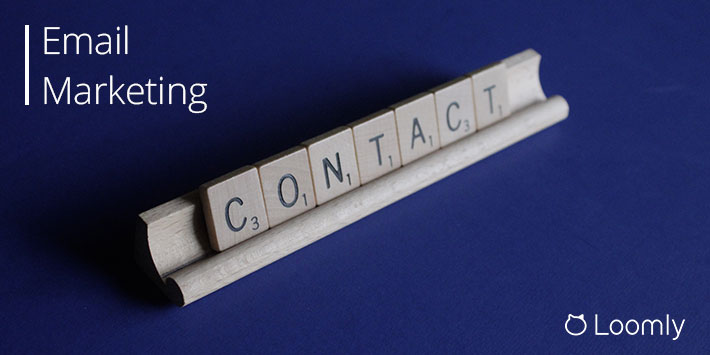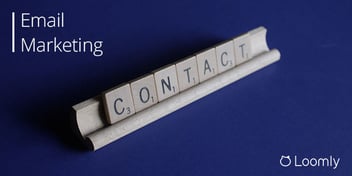Email Marketing FAQ
Wondering if email marketing still works? Reckon it might be declining?
Think again.
Email marketing is one of the best-performing and most cost-effective marketing channels, with an average ROI of 4200%.
Still not convinced?
Then check out the email marketing FAQ below as the Loomly Team answers all your questions.
TABLE OF CONTENTS
- What is email marketing?
- What does email marketing include?
- What is email marketing used for?
- What are the 9 types of marketing emails?
- What are the 5 Ts of email marketing?
- What are the benefits of email marketing?
- Which mistakes should you avoid with email marketing?
- Does email marketing work?
- What is the ROI of email marketing?
- Can I send marketing emails to my customers?
- How do you get started with email marketing?
- What is the best time to send an email marketing campaign?
- How much does email marketing cost?
- What are the best email marketing tools?
What is email marketing?
Email marketing is a powerful digital marketing channel that allows you to send various types of content to a list of subscribers via email. You can use it to generate leads, promote brand awareness, convert prospects into customers, and turn customers into loyal fans.
What does email marketing include?
Email marketing includes selling products, sharing some news, improving your cart abandonment rate, or telling a story.
What is email marketing used for?
Email marketing is used to deliver important information, drive sales, improve brand loyalty, and build a community around your brand (e.g. with a newsletter). The modern email marketing approach focuses on personalization, segmentation, and consent rather than a one-size-fits-all approach.
What are the 9 types of marketing emails?
Here are nine different types of marketing emails you can send:
- Welcome emails
- Email newsletters
- Dedicated emails
- Lead nurturing emails
- Sponsorship emails
- Transactional emails
- Re-Engagement emails
- Brand story emails
- Review request emails
What are the 5 Ts of email marketing?
The five Ts of email marketing are:
- Tease. Use your subject line to tease the email content inside, but make sure you can deliver on the promise.
- Target. The more personalized communication is, the better it will perform.
- Teach. Using your email as a teaching tool not only increases customer engagement but also helps build your brand perception.
- Test. Why pick one subject line when you can test two or three?
- Track. Not only can you show your improvement over time (or react quickly to remedy a misstep), but you can also plan content accordingly based on audience engagement.
What are the benefits of email marketing?
Here are the top 10 benefits of email marketing:
- Targeted and personalized content
- Build credibility
- Better brand recognition
- Boost sales
- Stronger customer relationships
- Optimize your time and budget
- Reporting helps you to learn what works
- Increased traffic to your website
- Establish authority
- Build excitement
Here are a further 29 benefits of email marketing shared by small businesses:
- Build credibility with your customers (and prospects)
- Get more people to call you to do business
- Increase donations to your cause
- Strengthen relationships with your customers
- Improve communication to keep your customers informed
- Build your brand
- Boost your sales and revenue
- Learn what works and see the impact of your marketing efforts
- Get started quickly and get professional assistance
- Reach people on any device
- Get more from doing less with pre-built templates
- Look professional with expertly designed email templates
- Increase website traffic
- Market with a personal touch
- Get immediate results
- Generate more leads
- Build excitement
- Start a conversation
- Promote services
- Grow your audience
- Stay organized with segmentation
- Increase your value
- Attract new clients and customers
- Save time
- With email marketing, you’re not alone
- Stay top-of-mind
- Improve awareness of everything you offer
- Book more classes
- Maintain vendor relationships
Which mistakes should you avoid with email marketing?
Here are 10 things you should never do in email marketing:
- Overhyping subject lines.
- Sending from a “no-reply” email address or name.
- Emailing offers that have no value.
- Using too many CTAs.
- Creating an email message that’s too long.
- Forgetting to test personalization tags.
- Neglecting to segment your email list.
- Failing to optimize for mobile.
- Sending emails at the wrong time or sending too many emails.
- Ignoring analytics.
Does email marketing work?
According to a study by McKinsey & Company, email marketing is up to 40 times more effective than social media. The same research also shows that the buying process happens 3 times faster with email than social media.
What is the ROI of email marketing?
According to an eMarketer study, the median email marketing ROI is 122%. That’s four times higher than any other digital marketing channel.
Can I send marketing emails to my customers?
Most country’s email marketing laws stipulate that people need to give you permission to email them before you send them campaigns.
The definition of permission varies between each country’s laws, but there are generally two types of permission: implied permission and express permission.
Implied permission describes someone who has an existing business relationship with you. For example, they are a current customer, donate to your charity, or are an active member of your website, club, or community.
Express permission describes someone who explicitly gives you permission to send them email campaigns. For example, by entering their email address in a subscribe form on your website or entering their details into your in-store newsletter subscribe form.
Bottom line: You should not send an email to someone without their implied or express permission.
How do you get started with email marketing?
Follow this 5-step framework to get started with email marketing:
- Establish your goals
- Build your email list
- Select the type of campaigns you want to send
- Create your first campaign
- Measure your results
What is the best time to send an email marketing campaign?
The answer to “what is the best time to send an email campaign?” is that there is no single “best time” to send an email – it depends on your audience.
If you don’t have enough data, the mid-day, mid-week motto is a great place to start and should perform decently enough.
However, if you really want to send your email campaigns at the best time for optimal opens and clicks, you need to TEST.
A/B test your send times like crazy – it’s the best way to find the perfect send time for your particular audience.
How much does email marketing cost?
On average, a mid-size business can expect to spend $9 – $1,000 per month on email marketing if they self-manage their campaigns (depending on the platform and number of subscribers) or $300 – $500 per month if they work with an agency.

Source: WebFX
What are the best email marketing tools?
Email marketing tools help marketers send commercial messages to groups of people via email. Typically, they let you:
- Design and build customized emails via HTML/CSS or WYSIWYG editors.
- Preview and send test emails.
- Store, track, segment, and manage email contact lists (subscribers).
- Provide campaign-based reporting and analytics.
Here’s our Top 5 email marketing tools (listed alphabetically):

Manage all your social media accounts in one place.
Craft, schedule, & auto-post content to all your social channels, then track analytics and manage interactions from a single, easy-to-use dashboard.
Email Marketing FAQ in a Nutshell
Email marketing is still alive and kicking.
By gaining subscribers’ consent and using segmentation and personalization, you can use it to send various types of email campaigns that generate leads, promote brand awareness, convert prospects into customers, and turn customers into loyal fans.



